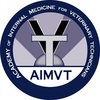A NOTE FOR INTERNATIONAL CANDIDATES:
AIMVT is a US-based organization and the AIMVT certifying exam was originally developed for candidates from the United States. Therefore, expect to see information on the exam that may be specific to the US. Every effort has been made to make the exam as location-independent as possible, however some differences may exist.
AIMVT is a US-based organization and the AIMVT certifying exam was originally developed for candidates from the United States. Therefore, expect to see information on the exam that may be specific to the US. Every effort has been made to make the exam as location-independent as possible, however some differences may exist.
Sample Questions
These questions were pulled from the question banks of AIMVT Small Animal Internal Medicine
Domain – DISEASES
1. Which of the following groups of signs MOST accurately describes a state of diabetes ketoacidosis?
A. Metabolic acidosis, hyperglycemia, dehydration, ketonemia
B. Metabolic acidosis, hypoglycemia, dehydration, ketonemia
C. Respiratory acidosis, hyperglycemia, over hydration, ketonuria
D. Respiratory acidosis, hypoglycemia, over hydration, ketonuria
2. Which of the following two organs is leptospirosis MOST likely to affect?
A. Kidney and heart
B. Kidney and liver
C. Lungs and heart
D. Small intestine and liver
Domain – ANESTHESIA & ANALGESIA
3. Which of the following is considered a main contraindication for epidural injection?
A. Cardio-pulmonary depression
B. Coagulopathies
C. High risk anesthetic candidates
D. Prolonged duration of analgesia
Domain – DIAGNOSTIC & LABORATORY TESTS & STUDIES
4. The result of a serum trypsin-like immunoreactivity test is 0.5 ug/L. What is the most likely assessment?
A. Pancreatitis
B. Exocrine pancreatic insufficiency
C. Diabetes Mellitus
D. Pancreatic beta-cell aplasia
Answers 1. Answer: A 2. Answer: B 3. Answer: B 4. Answer: B
Domain – DISEASES
1. Which of the following groups of signs MOST accurately describes a state of diabetes ketoacidosis?
A. Metabolic acidosis, hyperglycemia, dehydration, ketonemia
B. Metabolic acidosis, hypoglycemia, dehydration, ketonemia
C. Respiratory acidosis, hyperglycemia, over hydration, ketonuria
D. Respiratory acidosis, hypoglycemia, over hydration, ketonuria
2. Which of the following two organs is leptospirosis MOST likely to affect?
A. Kidney and heart
B. Kidney and liver
C. Lungs and heart
D. Small intestine and liver
Domain – ANESTHESIA & ANALGESIA
3. Which of the following is considered a main contraindication for epidural injection?
A. Cardio-pulmonary depression
B. Coagulopathies
C. High risk anesthetic candidates
D. Prolonged duration of analgesia
Domain – DIAGNOSTIC & LABORATORY TESTS & STUDIES
4. The result of a serum trypsin-like immunoreactivity test is 0.5 ug/L. What is the most likely assessment?
A. Pancreatitis
B. Exocrine pancreatic insufficiency
C. Diabetes Mellitus
D. Pancreatic beta-cell aplasia
Answers 1. Answer: A 2. Answer: B 3. Answer: B 4. Answer: B
Reading List
Knowledge List |
Exam Domains/Exam Content |
